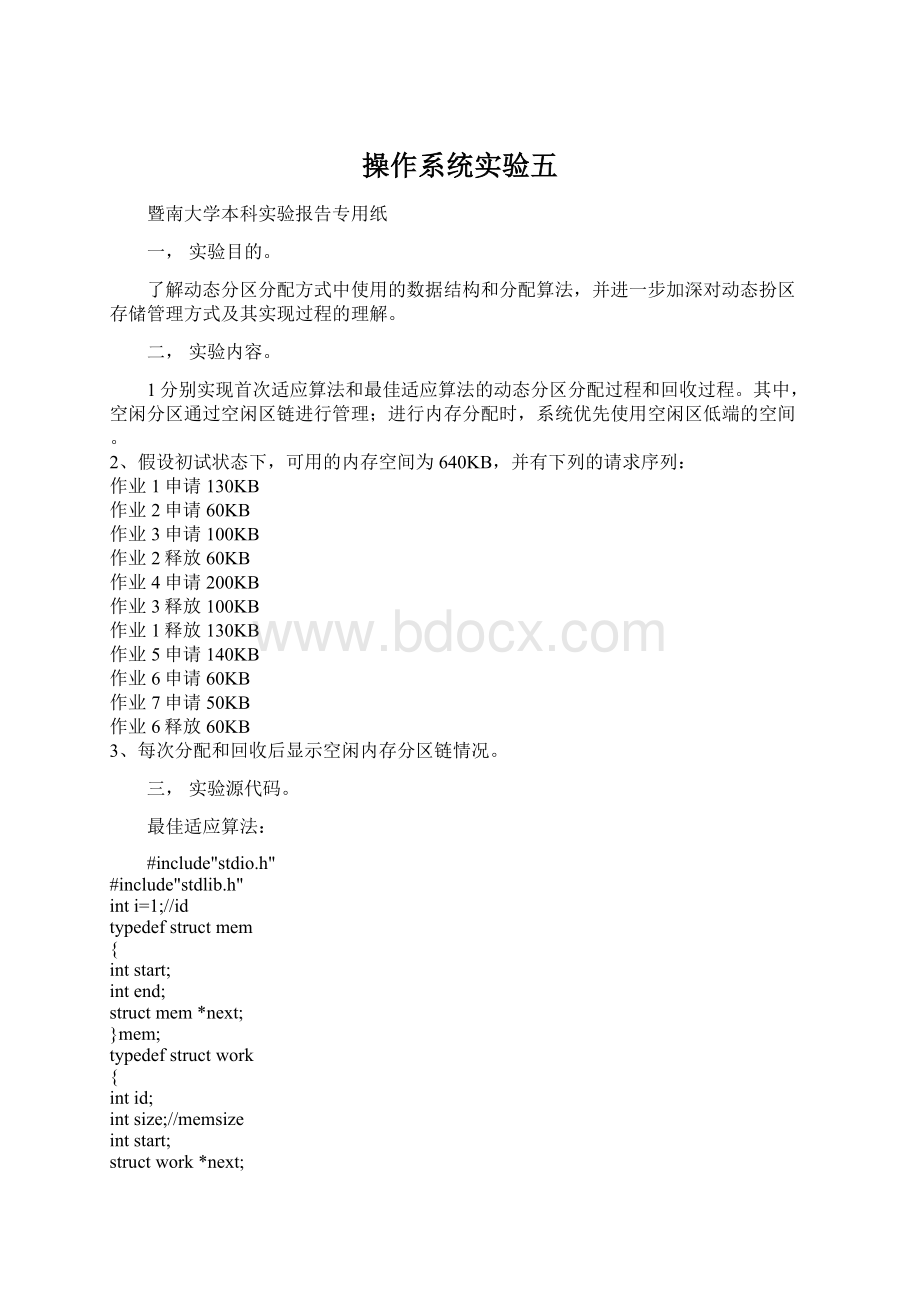操作系统实验五.docx
《操作系统实验五.docx》由会员分享,可在线阅读,更多相关《操作系统实验五.docx(9页珍藏版)》请在冰豆网上搜索。

操作系统实验五
暨南大学本科实验报告专用纸
一,实验目的。
了解动态分区分配方式中使用的数据结构和分配算法,并进一步加深对动态扮区存储管理方式及其实现过程的理解。
二,实验内容。
1分别实现首次适应算法和最佳适应算法的动态分区分配过程和回收过程。
其中,空闲分区通过空闲区链进行管理;进行内存分配时,系统优先使用空闲区低端的空间。
2、假设初试状态下,可用的内存空间为640KB,并有下列的请求序列:
作业1申请130KB
作业2申请60KB
作业3申请100KB
作业2释放60KB
作业4申请200KB
作业3释放100KB
作业1释放130KB
作业5申请140KB
作业6申请60KB
作业7申请50KB
作业6释放60KB
3、每次分配和回收后显示空闲内存分区链情况。
三,实验源代码。
最佳适应算法:
#include"stdio.h"
#include"stdlib.h"
inti=1;//id
typedefstructmem
{
intstart;
intend;
structmem*next;
}mem;
typedefstructwork
{
intid;
intsize;//memsize
intstart;
structwork*next;
}work;
work*initwork(intsize)
{
work*head=(work*)malloc(sizeof(head));
head->id=i;
head->start=1;
head->size=size;
head->next=NULL;
returnhead;
}
work*insertwork(work*head,intstart,intsize)
{
i++;
work*pi,*pb;//piistheinsertone##pbisthepoint
pi=(work*)malloc(sizeof(work));
pi->id=i;
pi->start=start;
pi->size=size;
pi->next=NULL;
if(head==NULL){head=pi;head->next=NULL;}
pb=head;
while(pb->next!
=NULL){pb=pb->next;}
pb->next=pi;
returnhead;
}
mem*initmem(intsize)
{
mem*head=(mem*)malloc(sizeof(mem));
head->start=1;
head->end=640;
head->next=NULL;
returnhead;
}
mem*insertmem(mem*head,intstart,intsize)
{
mem*pi,*pb,*pf;
intpbsize;
pb=head;
pbsize=pb->end-pb->start+1;
pi=(mem*)malloc(sizeof(mem));
pi->start=start;
pi->end=size+start-1;
if(pb==NULL){head=pi;pi->next=NULL;}
else
{
while(pi->start>pb->start&&pb->next!
=NULL){pf=pb;pb=pb->next;}
if(pi->startstart)
{
if(pb==head)
{
head=pi;//头节点
pi->next=pb;
}
else
{
pf->next=pi;//其他位置
pi->next=pb;
}
}
else
{
pb->next=pi;
pi->next=NULL;//在表末插入
}
}
//合并相邻的内存
pf=pb=head;
while(pb->next!
=NULL)
{
if(pf->end+2>pb->start)
{
pf->end=pb->end;
pf->next=pb->next;
}
pf=pb;
pb=pb->next;
}
returnhead;
}
intgetstart(work*head,intsize)
{
work*pb;
pb=head;
while(pb!
=NULL)
{
if(pb->size==size)
{
returnpb->start;
}
pb=pb->next;
}
return0;
}
intalloc(mem*head,intsize)
{
mem*pb;
pb=head;
inta;
while(pb!
=NULL)
{
if(size<=(pb->end-pb->start+1))
{
a=pb->start;
pb->start=pb->start+size;
returna;
}
pb=pb->next;
}
return0;
}
work*free1(work*head,intsize)
{
work*pb,*pf;
while(head==NULL){printf("nothisnod");gotoend;}
pb=head;
while(pb->size!
=size&&pb->next!
=NULL)
{
pf=pb;
pb=pb->next;
}
if(pb->size==size)
{
if(pb==head)head=pb->next;
elsepf->next=pb->next;
}
end:
returnhead;
}
voidprintw(work*head)
{
work*pb;
pb=head;
while(pb!
=NULL)
{
printf("id start size---->\n");
printf("%d%7d%8d\n",pb->id,pb->start,pb->size);
pb=pb->next;
}
}
voidprintm(mem*head)
{
mem*pb;
pb=head;
while(pb!
=NULL)
{
printf("start end---->\n");
printf("%d%9d\n",pb->start,pb->end);
pb=pb->next;
}
}
voidmain()
{
intwrec;//接收返回的地址
intmrec;
mem*mhead;
mhead=initmem(640);
work*whead;
//1
whead=initwork(130);
wrec=alloc(mhead,130);
//2
wrec=alloc(mhead,60);
whead=insertwork(whead,wrec,60);
//3
wrec=alloc(mhead,100);
whead=insertwork(whead,wrec,100);
//4
mrec=getstart(whead,60);
whead=free1(whead,60);
mhead=insertmem(mhead,mrec,60);
//5
wrec=alloc(mhead,200);
whead=insertwork(whead,wrec,200);
//6
mrec=getstart(whead,100);
whead=free1(whead,100);
mhead=insertmem(mhead,mrec,100);
//7
mrec=getstart(whead,130);
whead=free1(whead,130);
mhead=insertmem(mhead,mrec,130);
//8
wrec=alloc(mhead,140);
whead=insertwork(whead,wrec,140);
//9
wrec=alloc(mhead,60);
whead=insertwork(whead,wrec,60);
//10
wrec=alloc(mhead,50);
whead=insertwork(whead,wrec,50);
//11
mrec=getstart(whead,60);
whead=free1(whead,60);
mhead=insertmem(mhead,mrec,60);
printf("作业的链表\n");
printw(whead);
printf("========================\n");
printf("空闲分区链表\n");
printm(mhead);
}
首次适应算法:
#include"stdio.h"
structallocquery/*定义请求序列结构体*/
{
intnum;
intstate;/*a表示申请,f表示释放*/
intlength;
};
structallocqueryallocq[11];
structfreequery/*定义内存分配队列*/
{
intflag;/*IDNo.0表示空闲,其他数值表示相应作业*/
intfirstadd;/*起始地址*/
intlength;/*占有长度*/
};
structfreequeryfreeq[11];
/*首次适应算法函数*/
voidfirst_alg(structallocqueryallocqnow,int*ptotal,structfreequery*pfreeq);
main()
{
inti,j;
FILE*fp;
char*fname="c:
\\a.txt";
intFreetotal=1;
fp=fopen(fname,"w+");
allocq[0].num=1;allocq[0].state='a';allocq[0].length=130;
allocq[1].num=2;allocq[1].state='a';allocq[1].length=60;
allocq[2].num=3;allocq[2].state='a';allocq[2].length=100;
allocq[3].num=2;allocq[3].state='f';allocq[3].length=60;
allocq[4].num=4;allocq[4].state='a';allocq[4].length=200;
allocq[5].num=3;allocq[5].state='f';allocq[5].length=100;
allocq[6].num=1;allocq[6].state='f';allocq[6].length=130;
allocq[7].num=5;allocq[7].state='a';allocq[7].length=140;
allocq[8].num=6;allocq[8].state='a';allocq[8].length=60;
allocq[9].num=7;allocq[9].state='a';allocq[9].length=50;
allocq[10].num=6;allocq[10].state='f';allocq[10].length=60;
freeq[0].flag=0;freeq[0].firstadd=0;freeq[0].length=640;
for(i=0;i<11;i++)
{
first_alg(allocq[i],&Freetotal,freeq);
fprintf(fp,"\nTotalfreeblocks:
%d",Freetotal);
fprintf(fp,"\nIDNo.addresslength");
for(j=0;freeq[j].length!
=0;j++)
fprintf(fp,"\n%5d%10d%10d",freeq[j].flag,freeq[j].firstadd,freeq[j].length);
}
}
voidfirst_alg(structallocqueryallocqnow,int*ptotal,structfreequery*pfreeq)
{
inti,j,num;
inttemp_num,temp_add,temp_length;
structfreequerytemp_f1,temp_f2;
if(allocqnow.state=='a')/*表示申请空间*/
{
for(i=0;i<11;i++)
{
if((pfreeq[i].flag==0)&(pfreeq[i].length>allocqnow.length))
{
temp_num=pfreeq[i].flag;
temp_add=pfreeq[i].firstadd+allocqnow.length;
temp_length=pfreeq[i].length-allocqnow.length;
pfreeq[i].flag=allocqnow.num;
pfreeq[i].length=allocqnow.length;
if(pfreeq[i+1].length==0)
{
pfreeq[i+1].flag=temp_num;
pfreeq[i+1].firstadd=temp_add;
pfreeq[i+1].length=temp_length;
}
else
if(pfreeq[i+1].firstadd!
=temp_add)
{
temp_f1.flag=temp_num;temp_f1.firstadd=temp_add;temp_f1.length=temp_length;
temp_f2=pfreeq[i+1];
for(j=i+1;pfreeq[j].length!
=0;j++)
{
pfreeq[j]=temp_f1;
temp_f1=temp_f2;
temp_f2=pfreeq[j+1];
}
pfreeq[j]=temp_f1;
}
break;
}
}
}
else/*释放空间*/
{
for(i=0;i<11;i++)
{
if(pfreeq[i].flag==allocqnow.num)
{
if((pfreeq[i-1].flag==0)&(pfreeq[i+1].flag==0)&(i>0))
{
pfreeq[i-1].length=pfreeq[i-1].length+allocqnow.length+pfreeq[i+1].length;
for(j=i;pfreeq[j].length!
=0;j++)
{
pfreeq[j].flag=pfreeq[j+2].flag;
pfreeq[j].firstadd=pfreeq[j].firstadd;
pfreeq[j].length=pfreeq[j].length;
}
}
elseif((pfreeq[i-1].flag==0)&(i>0))
{
pfreeq[i-1].length=pfreeq[i-1].length+allocqnow.length;
for(j=i;pfreeq[j].length!
=0;j++)
{
pfreeq[j].flag=pfreeq[j+1].flag;
pfreeq[j].firstadd=pfreeq[j+1].firstadd;
pfreeq[j].length=pfreeq[j+1].length;
}
}
elseif(pfreeq[i+1].flag==0)
{
pfreeq[i].flag=0;
pfreeq[i].length=allocqnow.length+pfreeq[i+1].length;
for(j=i+1;pfreeq[j].length!
=0;j++)
{
pfreeq[j].flag=pfreeq[j+1].flag;
pfreeq[j].firstadd=pfreeq[j+1].firstadd;
pfreeq[j].length=pfreeq[j+1].length;
}
}
else
{
pfreeq[i].flag=0;
}
}
}
}
num=0;/*统计空闲块*/
for(i=0;pfreeq[i].length!
=0;i++)
if(pfreeq[i].flag==0)num++;
*ptotal=num;
}
四,实验结果。
五、实验心得
通过这次实验,取用首次适应算法和最佳适应算法了解了动态分区分配方式中使用的数据结构和分配算法,以及了解了动态分区存储管理方式。